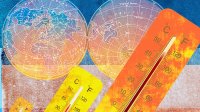Using Place-Based Learning to Teach Middle School Students About Climate Change
Climate change lessons become more relevant to students when they learn about how it’s affecting their communities.
Your content has been saved!
Go to My Saved Content.How do we prepare today’s youth for a future defined by the climate crisis?
As a middle school science teacher, I have grappled with this question. Many communities are already feeling the impacts of rising sea levels, extreme weather events, biodiversity loss, and environmental degradation. The future workforce will require eco-literate people who are equipped to address climate change in their communities. As we work toward a more sustainable world, educators have an opportunity to instill a sense of responsibility and environmental stewardship in the next generation.
From my experience, if you ask a group of middle school students how climate change has affected their lives, most will shrug their shoulders. That’s because climate change education is often taught in the global context, leaving kids feeling disconnected and powerless.
According to several studies on effective climate change education, engaging students in place-based learning increases their understanding of climate change. Learning experiences focused on local issues and phenomena connect students with their communities while providing context for climate change and its impacts. By working to strengthen a child’s sense of place, educators can foster positive relationships with the environment and empower students to take action in their communities.
But how can educators bring place-based learning into the middle school classroom? Surprisingly, online tools can be a great place to start. Organizations such as NASA (National Aeronautics and Space Administration), NOAA (National Oceanic and Atmospheric Association), the EPA (Environmental Protection Agency), and the CDC (Centers for Disease Control and Prevention) provide interactive maps where students can engage with real-time data from their community.
These user-friendly tools are accessible to any educator looking to bring climate change education down to the local level. Whether exploring the local landscape, biodiversity, sea levels, or environmental justice, using interactive maps can help get the conversation started.
5 Online Tools for Place-Based Learning
1. Images of Change from NASA. Using satellite imagery can be an effective way to teach middle school students about the impacts of climate change on local landscapes. NASA’s Images of Change provides breathtaking images of altered landscapes all over the world. In an interactive format, this tool allows students to view the impacts of drought, flooding, habitat loss, and extreme weather events. My students made observations of landscape changes in California by using the toggle feature to compare images side by side.
2. Biodiversity hot spot maps from ArcGIS Living Atlas of the World. This tool helps students visualize real-time data with biodiversity hot spot maps. A location-based data platform, ArcGIS Living Atlas of the World has imagery that shows species richness, imperiled species, and areas of biodiversity importance. My students used these maps to explore biodiversity in our region, which sparked deeper conversations about the impacts of climate change on vulnerable species.
3. EJScreen from the EPA. Looking to incorporate environmental justice education in your lessons? EJScreen, the EPA’s screening and mapping tool, allows students to dissect different aspects of environmental inequities.
Students can enter their city and use the map to access visuals of local data, including pollution levels, socioeconomic indicators, and health disparities. By exploring the different levels of air pollution in their hometown, my middle school students were able to reflect on the unequal distribution of resources and environmental hazards in their community.
4. Heat and Health Tracker from the CDC. Human health and well-being are directly affected by climate change, especially as the prevalence of extreme heat events increases. The CDC’s Heat and Health Tracker provides local data that can be used to help students make the connection between rising temperatures and human health.
Students can use the visual map and search function to find out how their county is impacted by extreme heat events and which areas are most vulnerable. The tracker also allows students to access resources available in their area.
5. Sea Level Rise Viewer from NOAA. Live in a coastal area? This online tool helps users visualize the current and potential impacts of sea-level rise on coastal communities. NOAA’s Sea Level Rise Viewer provides information on flooding risks and makes predictions of sea-level scenarios for the future. This user-friendly tool allowed my students to assess sea-level rise projections on their favorite beaches and parks.
Place-based learning can bring to life complex topics and help students feel more connected to their world. Using online mapping tools to engage with local data has allowed my students to form a deeper understanding of the impacts that climate change has on their community. When educators help students interpret and reflect on local issues, it can provide a stepping stone toward meaningful climate change education, with the hopes of promoting environmental stewardship.
